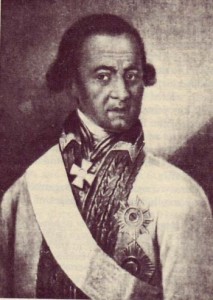GOOD MONDAY MORNING, P.O.U.!
Considering everything going on in the news, I’d thought it would be fitting to repost our series on Black historical and present day figures in Russia.
First, a brief history….
First African Arrivals
It is thought that the first Afro-Russians were a group of 20 men from Ethiopia who came as diplomats of the Abyssinian Empire, some of them being originally purchased as slaves and transported to the Crimea by Ottoman Turkish traders in the 1670s as gifts of diplomatic friendship from Abyssinia (as Ethiopia was otherwise known) to the Russians. They were subsequently turned into hired servants by the Tsarist Russian imperial family, the Romanovs. In fact, the Afro-Russian assistants in the Romanov estates rose in prominence, and often received an education. Pushkin’s great-grandfather, Abram Petrovich Gannibal (1696–1781), was a black imperial page, originally of a chiefly family in his native Africa, that was raised by Emperor Peter the Great himself. He is supposed to have written literature that Peter enjoyed reading, and eventually died a nobleman of Russia.
Early Soviet Period
After the revolution several Black African and mixed-race families came to the Soviet Union under the auspices of the Comintern. They were chiefly specialists in the spheres of industrial production and agriculture. The technical equipment, modest means, and professional experience brought by them were an appreciable contribution to economic development of a new state. Among them were Oliver John Golden and his wife Bertha (he brought with him a group of 16 Afro-American experts in the cultivation of cotton), well-known African-American poet Langston Hughes with a group of 22 filmmakers, Paul Robeson with his family and many others. Some of them stayed in Russia and their descendants still live there.
Post War, The Festival Children
When African nations gained independence from colonialism, the Soviet Union offered scholarships to young people from these nations. About 400,000 Africans studied in the former Soviet Union between the late 1950s and 1990.[3] The first significant arrival of Africans was for the 6th World Festival of Youth and Students held in Moscow in 1957. Many Africans also attended the Patrice Lumumba University. Hence colloquial terms for Afro-Russians born in the 1950s and 1960s are “Children of the Festival” (ru) or “Children of Lumumba”. Some of these children subsequently returned to their African parents’ countries or moved on to Western Europe or in the case of Jewish Afro-Russians to Israel.
Post Soviet Period
After the collapse of the Soviet Union racism and xenophobic sentiments have increased in the modern Russian state, particularly, due to mass immigration and falling birth rates amongst Slavic Russians. Afro-Russians are subjected to threats and violence on the part of ultra-nationalists and white power skinheads. After the 1990s, there has also been new residents including professional athletes of Black African descent including African Americans and Afro-Brazilians playing for Russian sports teams.
(SOURCE: Wikipedia)
Abram Petrovich Gannibal (aka Hannibal)
(1696-1781)
Sold into Turkish slavery, Abram Petrovich Hannibal was brought as a black servant to Czar Peter I, known as Peter the Great. He became one of the royal favorites, a general-in-chief, and one of the best educated men in Russia in his era. His great-grandson was Alexander Pushkin, the famous Russian writer who later glorified the deeds of his black ancestor in his book, The Negro of Peter the Great.
Hannibal was born on an unknown date around 1696 in the principality of Logon in present day Cameroon. Abducted by a rival ethnic group, Hannibal was sold to Turkish slave traders who brought him to Constantinople in 1703. As an eight-year-old boy he was brought to the court of Peter the Great who adopted him immediately. Being the Czar’s godson, Hannibal assumed his name, Petrovich, and became his valet on Peter’s various military campaigns and journeys. When the Czar visited France in 1716, Hannibal was left behind in Paris to study engineering and mathematics at a military school. Two years later, he joined the French army and fought in the war against Spain. In January 1723, Hannibal finally returned to Russia.
To Hannibal’s misery, his protector, Peter the Great, died in 1725, leaving the young black artillery lieutenant dependent upon the royal advisor Prince Menshikov, who, due to his dislike of Hannibal, assigned him first to Siberia and later to the Chinese border where his task was to measure the Great Wall.
Hannibal’s fortunes changed in 1741, when Empress Elisabeth took the throne and Hannibal was allowed to officially return from his exile although in fact he had done so clandestinely in 1731. Five years after his illegal return, he married his second wife Christina Regina von Schöberg, the daughter of a Swedish army captain, who bore him eleven children. One of his sons, Osip, was the grandfather of the poet Alexander Pushkin.
Although it had been Hannibal’s wish to retire, Empress Elisabeth did not want to abandon him or his engineering skills. He was made military commander of the city of Reval, serving between 1743 and 1751 and by 1760 had been promoted to the rank of a full general. During his military career he oversaw various projects including part of the expansion of the 73 mile Ladoga Canal near St. Petersburg which linked the Neva and Svir Rivers, and Russian fortresses throughout the empire. Abram Petrovich Hannibal died on April 20, 1781, as one of the leading military figures in his country and probably the first outstanding engineer in Russian history.
(SOURCE: Blackpast.org)

